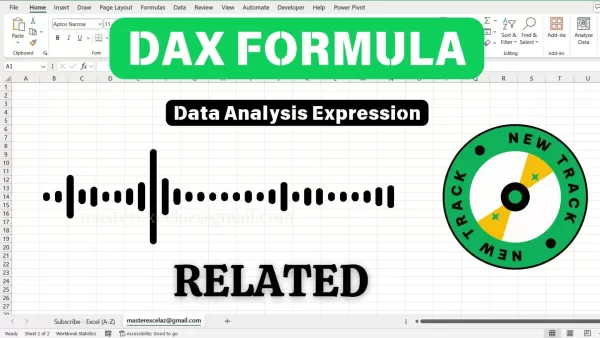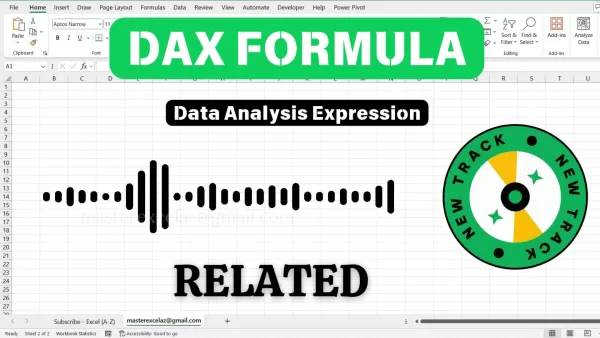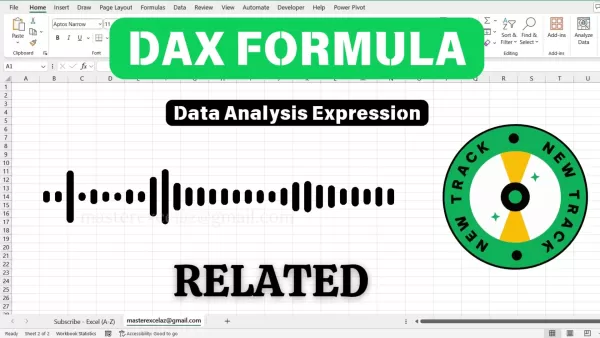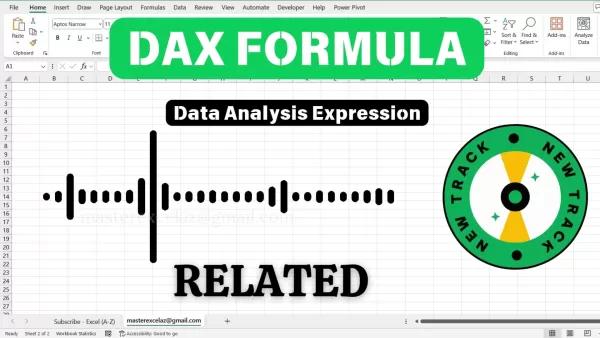Master the RELATED Function in DAX Formula Explained
Mastering the RELATED Function in DAX: A Game-Changer for Excel Data Analysis
In today’s data-driven world, Excel’s DAX formulas are revolutionizing how businesses analyze and interpret information. Among these, the RELATED function stands out as a powerful tool for effortlessly connecting data across tables. If you’ve ever struggled with manual lookups or complex VLOOKUP formulas, this guide will show you a smarter, more efficient way to work with related datasets.
Why the RELATED Function is a Must-Know for Data Analysts
The RELATED function in DAX (Data Analysis Expressions) is designed to pull data from a related table based on predefined relationships. Unlike traditional Excel functions, it eliminates the need for repetitive lookups, ensuring accuracy, efficiency, and dynamic updates—key elements for making informed business decisions.
Key Advantages of Using RELATED Over VLOOKUP
While VLOOKUP has been a go-to for years, RELATED offers significant improvements:
- Dynamic & Automatic Updates – Unlike
VLOOKUP, which requires manual adjustments if data changes, RELATED automatically syncs with your dataset. - Better Performance – Handles large datasets more efficiently, reducing lag and calculation time.
- Data Integrity – Works within a structured data model, minimizing errors from mismatched references.
- Simpler Syntax – No need for complex nested formulas—just a straightforward reference to the related column.

Prerequisites: What You Need Before Using RELATED
Before diving into RELATED, ensure your Excel setup meets these requirements:
✅ Power Pivot Enabled – The RELATED function relies on Excel’s Power Pivot add-in, so make sure it’s activated.
✅ Defined Table Relationships – Your tables must be linked via a one-to-many relationship (e.g., a Customer ID connecting a Sales table to a Customers table).
✅ DAX Basics – While RELATED is simple, a basic understanding of DAX syntax helps in leveraging its full potential.

Step-by-Step: How to Set Up Table Relationships
- Import Your Data – Ensure each dataset is in its own table.
- Open Power Pivot → Click Manage to access the data model.
- Switch to Diagram View – This visual layout makes it easy to see connections.
- Drag & Drop to Link Tables – Click and drag from a key field (e.g., Product ID) in one table to the corresponding field in another.
- Verify the Relationship – Ensure it’s a one-to-many connection (one unique record in the "one" side, multiple in the "many" side).

Real-World Examples: How to Use RELATED Effectively
Example 1: Adding Product Categories to a Sales Table
Scenario: You have a Sales table with transaction details and a Products table with category info. You want to display the product category alongside each sale.
Solution:
- In the Sales table, add a calculated column.
- Enter:
=RELATED(Products[Category])
- Excel automatically pulls the correct category for each product ID.
Example 2: Calculating Customer Lifetime Value (CLTV)
Scenario: You need to analyze customer spending by linking Orders and Customers tables.
Solution:
- Create a calculated column in the Orders table:
=RELATED(Customers[TotalPurchases])
- Use this data to calculate average spend per customer and predict CLTV.
Common Pitfalls & How to Avoid Them
🚫 No Defined Relationship? → RELATED won’t work. Always verify table links.
🚫 Wrong Relationship Direction? → RELATED only works from the "many" side to the "one" side.
🚫 Circular References? → Can cause errors; ensure your model avoids loops.

RELATED vs. VLOOKUP: Which Should You Use?
Feature RELATED (DAX) VLOOKUP Dynamic Updates ✅ Yes ❌ No (Manual refresh needed) Performance ⚡ Faster with big data 🐢 Slower with large datasets Ease of Use ✔ Simple syntax ❗ Complex for multiple conditions Data Integrity 🔒 Secure (relies on relationships) 🚧 Prone to errors if data shifts
FAQs: Quick Answers to Common Questions
❓ Can RELATED pull data from multiple tables at once?
No—it retrieves from one related table per formula. For multi-table pulls, use LOOKUPVALUE or nested DAX functions.
❓ What if no matching value exists?
It returns a blank instead of an error, making debugging easier.
❓ Can RELATED be used in measures?
Yes, but context matters—measures evaluate differently than columns.
Final Thoughts: Is RELATED Right for You?
If you’re working with connected datasets in Power Pivot, RELATED is a must-use function. It simplifies lookups, improves accuracy, and saves time—making it a superior alternative to VLOOKUP in structured data models.
Pro Tip: For the best experience, pair RELATED with Power BI for even deeper data insights!
🚀 Ready to supercharge your Excel analysis? Start using RELATED today and see the difference!
Related article
 Best AI Tools for Creating Educational Infographics – Design Tips & Techniques
In today's digitally-driven educational landscape, infographics have emerged as a transformative communication medium that converts complex information into visually appealing, easily understandable formats. AI technology is revolutionizing how educa
Best AI Tools for Creating Educational Infographics – Design Tips & Techniques
In today's digitally-driven educational landscape, infographics have emerged as a transformative communication medium that converts complex information into visually appealing, easily understandable formats. AI technology is revolutionizing how educa
 Topaz DeNoise AI: Best Noise Reduction Tool in 2025 – Full Guide
In the competitive world of digital photography, image clarity remains paramount. Photographers at all skill levels contend with digital noise that compromises otherwise excellent shots. Topaz DeNoise AI emerges as a cutting-edge solution, harnessing
Topaz DeNoise AI: Best Noise Reduction Tool in 2025 – Full Guide
In the competitive world of digital photography, image clarity remains paramount. Photographers at all skill levels contend with digital noise that compromises otherwise excellent shots. Topaz DeNoise AI emerges as a cutting-edge solution, harnessing
 Master Emerald Kaizo Nuzlocke: Ultimate Survival & Strategy Guide
Emerald Kaizo stands as one of the most formidable Pokémon ROM hacks ever conceived. While attempting a Nuzlocke run exponentially increases the challenge, victory remains achievable through meticulous planning and strategic execution. This definitiv
Comments (4)
0/200
Master Emerald Kaizo Nuzlocke: Ultimate Survival & Strategy Guide
Emerald Kaizo stands as one of the most formidable Pokémon ROM hacks ever conceived. While attempting a Nuzlocke run exponentially increases the challenge, victory remains achievable through meticulous planning and strategic execution. This definitiv
Comments (4)
0/200
![RonaldWilliams]() RonaldWilliams
RonaldWilliams
 October 4, 2025 at 2:30:40 PM EDT
October 4, 2025 at 2:30:40 PM EDT
之前写DAX公式总被跨表查询卡住,这个RELATED函数简直是救命稻草啊!不过教程能不能再详细讲讲性能优化?处理百万行数据时会不会拖慢速度?🤔


 0
0
![DouglasScott]() DouglasScott
DouglasScott
 August 21, 2025 at 1:01:19 PM EDT
August 21, 2025 at 1:01:19 PM EDT
The RELATED function in DAX sounds like a total game-changer for Excel nerds like me! 😎 Makes connecting data tables feel like solving a puzzle. Anyone else geeking out over this?


 0
0
![JuanAllen]() JuanAllen
JuanAllen
 August 9, 2025 at 11:00:59 AM EDT
August 9, 2025 at 11:00:59 AM EDT
This article on the RELATED function is super helpful! 🥳 It makes connecting data in Excel feel like a breeze. Anyone else using DAX for big projects?


 0
0
![DouglasScott]() DouglasScott
DouglasScott
 July 22, 2025 at 2:33:07 AM EDT
July 22, 2025 at 2:33:07 AM EDT
The RELATED function sounds like a lifesaver for Excel nerds like me! 😍 Makes connecting data tables feel like a breeze.


 0
0
Mastering the RELATED Function in DAX: A Game-Changer for Excel Data Analysis
In today’s data-driven world, Excel’s DAX formulas are revolutionizing how businesses analyze and interpret information. Among these, the RELATED function stands out as a powerful tool for effortlessly connecting data across tables. If you’ve ever struggled with manual lookups or complex VLOOKUP formulas, this guide will show you a smarter, more efficient way to work with related datasets.
Why the RELATED Function is a Must-Know for Data Analysts
The RELATED function in DAX (Data Analysis Expressions) is designed to pull data from a related table based on predefined relationships. Unlike traditional Excel functions, it eliminates the need for repetitive lookups, ensuring accuracy, efficiency, and dynamic updates—key elements for making informed business decisions.
Key Advantages of Using RELATED Over VLOOKUP
While VLOOKUP has been a go-to for years, RELATED offers significant improvements:
- Dynamic & Automatic Updates – Unlike
VLOOKUP, which requires manual adjustments if data changes, RELATED automatically syncs with your dataset. - Better Performance – Handles large datasets more efficiently, reducing lag and calculation time.
- Data Integrity – Works within a structured data model, minimizing errors from mismatched references.
- Simpler Syntax – No need for complex nested formulas—just a straightforward reference to the related column.

Prerequisites: What You Need Before Using RELATED
Before diving into RELATED, ensure your Excel setup meets these requirements:
✅ Power Pivot Enabled – The RELATED function relies on Excel’s Power Pivot add-in, so make sure it’s activated.
✅ Defined Table Relationships – Your tables must be linked via a one-to-many relationship (e.g., a Customer ID connecting a Sales table to a Customers table).
✅ DAX Basics – While RELATED is simple, a basic understanding of DAX syntax helps in leveraging its full potential.

Step-by-Step: How to Set Up Table Relationships
- Import Your Data – Ensure each dataset is in its own table.
- Open Power Pivot → Click Manage to access the data model.
- Switch to Diagram View – This visual layout makes it easy to see connections.
- Drag & Drop to Link Tables – Click and drag from a key field (e.g., Product ID) in one table to the corresponding field in another.
- Verify the Relationship – Ensure it’s a one-to-many connection (one unique record in the "one" side, multiple in the "many" side).

Real-World Examples: How to Use RELATED Effectively
Example 1: Adding Product Categories to a Sales Table
Scenario: You have a Sales table with transaction details and a Products table with category info. You want to display the product category alongside each sale.
Solution:
- In the Sales table, add a calculated column.
- Enter:
=RELATED(Products[Category]) - Excel automatically pulls the correct category for each product ID.
Example 2: Calculating Customer Lifetime Value (CLTV)
Scenario: You need to analyze customer spending by linking Orders and Customers tables.
Solution:
- Create a calculated column in the Orders table:
=RELATED(Customers[TotalPurchases]) - Use this data to calculate average spend per customer and predict CLTV.
Common Pitfalls & How to Avoid Them
🚫 No Defined Relationship? → RELATED won’t work. Always verify table links.
🚫 Wrong Relationship Direction? → RELATED only works from the "many" side to the "one" side.
🚫 Circular References? → Can cause errors; ensure your model avoids loops.

RELATED vs. VLOOKUP: Which Should You Use?
| Feature | RELATED (DAX) | VLOOKUP |
|---|---|---|
| Dynamic Updates | ✅ Yes | ❌ No (Manual refresh needed) |
| Performance | ⚡ Faster with big data | 🐢 Slower with large datasets |
| Ease of Use | ✔ Simple syntax | ❗ Complex for multiple conditions |
| Data Integrity | 🔒 Secure (relies on relationships) | 🚧 Prone to errors if data shifts |
FAQs: Quick Answers to Common Questions
❓ Can RELATED pull data from multiple tables at once?
No—it retrieves from one related table per formula. For multi-table pulls, use LOOKUPVALUE or nested DAX functions.
❓ What if no matching value exists?
It returns a blank instead of an error, making debugging easier.
❓ Can RELATED be used in measures?
Yes, but context matters—measures evaluate differently than columns.
Final Thoughts: Is RELATED Right for You?
If you’re working with connected datasets in Power Pivot, RELATED is a must-use function. It simplifies lookups, improves accuracy, and saves time—making it a superior alternative to VLOOKUP in structured data models.
Pro Tip: For the best experience, pair RELATED with Power BI for even deeper data insights!
🚀 Ready to supercharge your Excel analysis? Start using RELATED today and see the difference!
 Best AI Tools for Creating Educational Infographics – Design Tips & Techniques
In today's digitally-driven educational landscape, infographics have emerged as a transformative communication medium that converts complex information into visually appealing, easily understandable formats. AI technology is revolutionizing how educa
Best AI Tools for Creating Educational Infographics – Design Tips & Techniques
In today's digitally-driven educational landscape, infographics have emerged as a transformative communication medium that converts complex information into visually appealing, easily understandable formats. AI technology is revolutionizing how educa
 Topaz DeNoise AI: Best Noise Reduction Tool in 2025 – Full Guide
In the competitive world of digital photography, image clarity remains paramount. Photographers at all skill levels contend with digital noise that compromises otherwise excellent shots. Topaz DeNoise AI emerges as a cutting-edge solution, harnessing
Topaz DeNoise AI: Best Noise Reduction Tool in 2025 – Full Guide
In the competitive world of digital photography, image clarity remains paramount. Photographers at all skill levels contend with digital noise that compromises otherwise excellent shots. Topaz DeNoise AI emerges as a cutting-edge solution, harnessing
 Master Emerald Kaizo Nuzlocke: Ultimate Survival & Strategy Guide
Emerald Kaizo stands as one of the most formidable Pokémon ROM hacks ever conceived. While attempting a Nuzlocke run exponentially increases the challenge, victory remains achievable through meticulous planning and strategic execution. This definitiv
Master Emerald Kaizo Nuzlocke: Ultimate Survival & Strategy Guide
Emerald Kaizo stands as one of the most formidable Pokémon ROM hacks ever conceived. While attempting a Nuzlocke run exponentially increases the challenge, victory remains achievable through meticulous planning and strategic execution. This definitiv
 October 4, 2025 at 2:30:40 PM EDT
October 4, 2025 at 2:30:40 PM EDT
之前写DAX公式总被跨表查询卡住,这个RELATED函数简直是救命稻草啊!不过教程能不能再详细讲讲性能优化?处理百万行数据时会不会拖慢速度?🤔


 0
0
 August 21, 2025 at 1:01:19 PM EDT
August 21, 2025 at 1:01:19 PM EDT
The RELATED function in DAX sounds like a total game-changer for Excel nerds like me! 😎 Makes connecting data tables feel like solving a puzzle. Anyone else geeking out over this?


 0
0
 August 9, 2025 at 11:00:59 AM EDT
August 9, 2025 at 11:00:59 AM EDT
This article on the RELATED function is super helpful! 🥳 It makes connecting data in Excel feel like a breeze. Anyone else using DAX for big projects?


 0
0
 July 22, 2025 at 2:33:07 AM EDT
July 22, 2025 at 2:33:07 AM EDT
The RELATED function sounds like a lifesaver for Excel nerds like me! 😍 Makes connecting data tables feel like a breeze.


 0
0





























